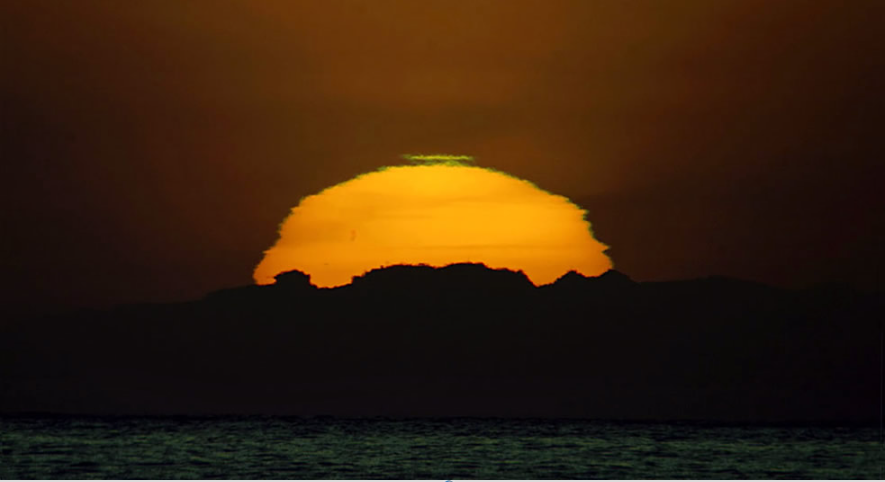Green flash Tenerife
Green Flash Tenerife: A Phenomenon Above the Horizon
Have you ever witnessed a mesmerizing green flash during a sunset? The island of Tenerife, with its unique atmospheric conditions, provides an ideal vantage point for experiencing this rare optical phenomenon. On October 24, '04, Tony Cook captured a series of three green flashes while observing the sunset from an elevation of 20-30ft above sea level. Let's delve deeper into the science behind this captivating event and explore the factors that contribute to its occurrence.
The Miraging and Magnifying Effects of a Vertically Wavy Inversion Layer
The green flash observed by Tony Cook is a variant of an M-Mir type, characterized by the miraging and magnifying effects of a vertically wavy inversion layer. This atmospheric phenomenon occurs when the layers in the atmosphere, shaped by vertical waves, create a distortion that results in the magnification necessary for the green flash to manifest. The flash itself appears above the astronomical horizon, indicating that the inversion layer cannot be at a constant height above the Earth's surface.
The Role of Atmospheric Waves in Creating the Green Flash
The vertical waves in the atmosphere play a crucial role in shaping the inversion layers responsible for the green flash. These waves cause variations in the curvature of the layers, and if a part of the inversion layer exhibits stronger curvature than that of the Earth's surface, it can give rise to the occurrence of the green flash above the astronomical horizon. This intricate interplay between atmospheric waves and the inversion layer contributes to the uniqueness and allure of this phenomenon.
Exploring the Red Rim and Solar Limb
Andrew Young, an expert in atmospheric optics, sheds light on additional intriguing aspects of the green flash phenomenon. He explains that the red rim observed where the Sun meets the clouds is a captivating example of a colored rim. Dispersion in the intervening atmosphere causes this red line along the apparent horizon, particularly noticeable when one is sufficiently far from it. Furthermore, the raggedness observed on the solar limb in Tony Cook's image suggests the possibility of breaking Kelvin-Helmholtz waves on some of the inversions, adding to the complexity of the atmospheric dynamics at play.
A Closer Look at Tony Cook's Image
In Tony Cook's photograph, we can observe a smudge to the left of the green flash, which corresponds to a mirage-distorted giant sunspot group named .687. This mirage effect is a result of the magnifying properties of the inversion layer, further enhancing the visual spectacle. The photograph captures not only the green flash but also provides a glimpse into other atmospheric phenomena that coexist during this magical moment.
The Intricacies of Green Flash Photography
Capturing a green flash on camera requires both skill and patience. Photographers must carefully consider factors such as elevation, atmospheric conditions, and the precise timing of the sunset to increase their chances of witnessing and immortalizing this ephemeral event. Tony Cook's successful capture of three green flashes during a single sunset is a testament to his dedication and expertise in atmospheric optics photography.
The Fascination of Atmospheric Optics
Atmospheric optics continues to captivate scientists and enthusiasts alike, offering a window into the complex interplay between light and the Earth's atmosphere. The green flash phenomenon serves as a reminder of the vast array of optical marvels that occur naturally around us. As we deepen our understanding of these phenomena, we gain valuable insights into the intricacies of our planet's atmosphere and its role in shaping our visual experiences.
Conclusion
The green flash observed in Tenerife showcases the stunning interplay between atmospheric conditions, inversion layers, and atmospheric waves. This rare optical phenomenon serves as a reminder of the boundless beauty present in our natural world. Whether through the lens of a camera or the naked eye, witnessing a green flash is a moment of awe and wonder, inviting us to explore the mysteries of atmospheric optics and appreciate the intricate tapestry of our planet's atmosphere.

Tony Cook imaged this flash from the island of Tenerife on October 24, '04. The sun is setting behind clouds. Tony was some 20-30ft above sea level and saw three green flashes during the one sunset. The flash is a variant of an M-Mir type produced by the miraging and magnifying effects of a vertically wavy inversion layer. The 'smudge' to the left is the mirage distorted giant sunspot group .687. More ↓
The inversion layer in this case cannot be at constant height above the earth's surface because the flash is above the astronomical horizon. The layers here (there are several) are likely shaped by vertical waves in the atmosphere. The magnification necessary for a flash occurs where a line from the eye is tangential to the convex lower edge of the inversion. If part of the layer has a stronger curvature than that of the earth due to atmospheric waves the flash can occur above the astronomical horizon.
Andrew Young adds: "The red rim where the Sun meets the clouds is a nice example of .a coloured rim.. If you are far enough from the apparent horizon it will have a red line along it like this because of dispersion in the intervening atmosphere. The general raggedness of the solar limb here suggests that there might be breaking Kelvin-Helmholtz waves on some of the inversions."
Image ©2004 Tony Cook, reproduced with permission.
Note: this article has been automatically converted from the old site and may not appear as intended. You can find the original article here.
Reference Atmospheric Optics
If you use any of the definitions, information, or data presented on Atmospheric Optics, please copy the link or reference below to properly credit us as the reference source. Thank you!
-
<a href="https://atoptics.co.uk/blog/green-flash-tenerife/">Green flash Tenerife</a>
-
"Green flash Tenerife". Atmospheric Optics. Accessed on December 23, 2024. https://atoptics.co.uk/blog/green-flash-tenerife/.
-
"Green flash Tenerife". Atmospheric Optics, https://atoptics.co.uk/blog/green-flash-tenerife/. Accessed 23 December, 2024
-
Green flash Tenerife. Atmospheric Optics. Retrieved from https://atoptics.co.uk/blog/green-flash-tenerife/.